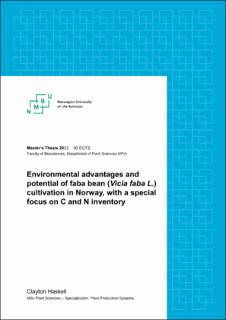| dc.description.abstract | Faba bean (Vicia faba L.) is a legume capable of BNF that has the potential to play a role in achieving climate goals while influencing the future of Norwegian agriculture. The GreenPlantFood project is exploring ways to improve sustainability of the farm to fork food system in Norway, and this thesis seeks to contribute both agronomic and plant residue information on faba bean grown in Norway. Faba bean is a high protein crop, and comparisons of food production in Norway have shown that faba bean production has 14-29 times lower GHG emissions per kg protein compared to dairy beef meat, and 9-15 times lower GHG emissions compared to milk. Faba bean also provides agronomic and environmental benefits in cultivation. Up to 200 kg N ha-1 N fertilizer can be saved in crops grown after faba bean, and grain yields respond positively to faba bean residue compared to other grain residue. BNF capabilities are thought to play a role in this, but the specific mechanisms behind these benefits are not completely understood. A collection of promising faba bean varieties were sown on two different dates (27 April, 14 May) at Vollebekk research farm in Ås. Two plots were sowed for each variety in both sowing times. A selection of 10 varieties from the 14 May sowing time were selected for full plant analysis. 0.5 m2 subplots were used for each of the 10 selected varieties. Plants from each subplot were harvested, measured, and divided into seeds, stems, pods, and leaves for nitrogen and carbon analysis.
Yield data from the full plots showed very little statistically significant differences between varieties, but sowing time had a significant effect on dry seed weight (p-value < 0.001). Mean dry seed weight for plants sown 27 April (6.63 kg) was significantly higher than mean dry seed weight for plants sown 14 May (5.18 kg). The plants sown 27 April received 42.9 °C extra degree days, and 35.5 mm additional precipitation. Subplot plant analysis showed that seeds had 4.59% N, leaves had 2.40% N, pods had 1.37% N, and stems had 0.69% N. These N contents support previous findings regarding faba bean residue nitrogen content. Carbon contents of plant residue parts were all roughly 40%. Of the plant material included in post-harvest plant residue, only leaves had above the 2% nitrogen content threshold that is necessary for successful nitrogen mineralization. Harvest index and residue nitrogen content were negatively correlated (Pearson’s r = - 0.776). High harvest index is important for the plant protein function of faba bean, and high residue nitrogen content is a valuable factor faba bean’s role in crop rotations. | en_US |

